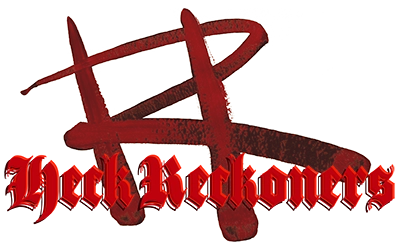Before I bring a song to the band, I usually record a demo at home. It usually won’t be the version that we bring to the stage – let alone what we put on the record – but it’s normally at least 60% of the way there. I’ve learned that if you show up to practice with only a riff or a chord progression, the band will either take it in four different directions at the same time, or jam it until we never want to play it again. In my experience, songwriting works best with one or two people in a room without a drum kit and 100 watt guitar amps as distractions.
Over the weekend I demo’d out a track tentatively titled “Arthropod,” whose length came to 10:02. That’s looong. Typically, our demos are shorter than their full band versions because we’ll elongate intros and outros, add a solo section or breakdown, or otherwise sharpen the tension and release. I’m sure “Arthropod” will undergo a similar refinement – and it might get nixed by the band altogether. You can’t make your mates play what they don’t want to unless your name is on the marquee – and you pay them well. Mine isn’t, and I don’t.
On the demo, “Arthropod” has a middle section inspired by sludge and doom metal. The tempo drops from 150 BPM to 100. With the full band, I imagine the guitars churning, the drums thundering, and the vocals wailing. There’s a concept at play here: I want to make a punk song devolve into a sludge song, grind to a halt, transform into something beautiful, and then become a punk song again. High expectations, I know. And trust me, they DON’T come across on the demo. But I think it’s a worthy ambition for a ten minute song.
I’ve only demo’d out one other ten minute track. Remember how I said you can’t make your mates play what they don’t want to unless your name is on the marquee? My name was not Part Time Ghost. Alas, my sci-fi/fantasy epic “Mona Lisa Overdrive” has remained a demo, despite having one really killer joke (“A bunch of fucking horses;” you had to be there). Unlike “Arthropod,” in which I hope to turn a punk band into a sludge band for seven minutes before turning back into a punk band, there wasn’t a conceptual hook to “Mona Lisa Overdrive.” My impetus to write the song: I had a half dozen riffs that didn’t fit anywhere else and couldn’t stand on their own, so I just figured, if it was good enough for The Beatles (whose second side of Abbey Road is a medley of songs that weren’t otherwise completed), it’s good enough for my dumb ass.
I think most long songs – let’s call them long at over ten minutes – come to their creators like “Mona Lisa Overdrive” came to me. You’ve a riff here, a chorus here, a neat dynamics trick that you’ve never used anywhere else, a synthesizer pedal that you paid $300 for and haven’t been able to shoehorn into another song. Take all that together and make a suite. Suites include Yes’s “Close to the Edge,” Grateful Dead’s “Terrapin Station,” Rush’s ”2112,” Blood Incantation’s “Awakening from the Dream of Existence to the Multidimensional Nature of Our Reality (Mirror of the Soul),” and the Abbey Road medley, which Beatles fans have incidentally dubbed “the long one.” These are multi-part songs jam-packed with musical ideas. Prog rock, in particular, loves a suite. For most intents and purposes, a suite is a bunch of small songs mashed into a big one.
But there is another type of long song. It’s not so much packed with musical information, as it is with weight. These are the epics. Epics aren’t a clearing house for musical ideas, rather they are the idea itself. What I mean is that the very point of an epic is to be long.
Greg Ginn complained to critics that Black Flag’s early songs weren’t any “shorter” than other bands, they were simply “faster.” There are just as many riffs, ideas and verses in the 2:20 of “Rise Above” as there are in, say, the 3:20 of “Keep On Loving You.” Black Flag just gets it out faster than REO Speedwagon. There’s a reverse logic at play with epics. Epics ask: why do in three minutes what you can do in thirteen? Epics are all about the journey. This is music to marinate in. The listener is supposed to get caught up in the groove, the tone, the atmosphere. They’re supposed to enjoy the ride – or, depending on the music’s intentions, not.
Epics can ride a groove, like Funkadelic’s “(Not Just) Knee Deep” or Kraftwerk’s “Autobahn.” They can ride a groove until the wheels come off, like Tortoise’s “Djed.” They don’t even need to build a groove at all, like Brian Eno’s “1/1” on Ambient 1: Music for Airports. Epics can build a panoramic world like Bob Dylan’s “Sad-Eyed Lady of the Lowlands.” They can dissolve into a feedback mist like Sonic Youth’s “The Diamond Sea,” or pummel you with a gospel drone (and harmonica!) like Spritualized’s “Cop Shoot Cop….”
But what epics are the best at doing, better than any other type of song, is starting small and building to a massive crescendo, like Mogwai’s “Like Herod,” or the many plus-size length tracks on YOB’s Our Raw Heart.
Doom metal is a genre of music that prides itself on being slow and heavy, and while there are certainly heavier bands (Sunn O))), springs to mind) and slower bands (check out the genre “funeral doom” if you’ve an entire week to kill), in my mind, YOB do the best at balancing slow and heavy. Most YOB songs start with a flutter of guitar strings or the tinkle of percussion before transforming into thunderous behemoths that churn and churn and churn for ten, sixteen, 22 minutes. The repetition of the songs build and build, as if amassing gravitational force, lulling the listener into, dare I say, a spiritual state. The whole point of a YOB track is to be absorbed into it, as if pleasantly drowning in an ocean of molasses.
Honestly, after listening back to “Arthropod,” I’ve become aware that it’s neither a suite nor an epic and, therefore, it doesn’t deserve to be ten minutes long. Why saddle it with that responsibility? I’ve decided to crack back into the demo and tighten up that middle section. Unless you’re certain that you’re making an epic, why do ten minutes when you can do it in seven?

